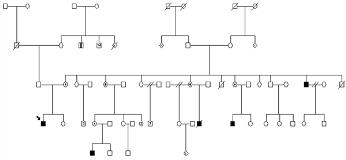BATHING EPILEPSY: REPORT OF A FRENCH-CANADIAN FAMILY WITH RECESSIVE X-LINKED INHERITANCE
Abstract number :
2.197
Submission category :
Year :
2003
Submission ID :
4059
Source :
www.aesnet.org
Presentation date :
12/6/2003 12:00:00 AM
Published date :
Dec 1, 2003, 06:00 AM
Authors :
Dang K. Nguyen, Jean-Marc Saint-Hilaire, Lionel Carmant, Anne Lortie, Micheline Gravel, Guy A. Rouleau, Patrick Cossette Service de Neurologie, Centre Hospitalier de l[apos]Universite de Montreal-Hopital Notre Dame, Montreal, QC, Canada; Service de Neurol
Although reflex epilepsies are relatively rare, their study may provide valuable insight into the mechanisms of epileptogenesis. Various visual, somatosensory, auditory or motor activities have been described to trigger seizures. Among the reflex epilepsies, seizures precipitated by bathing or water-immersion have been rarely reported. The pathophysiology of this epileptic syndrome is currently unknown, but familial aggregation has been reported in Indian population.
We studied 30 members of a French-Canadian family over 4 generations. Affected individuals from this kindred were followed in our epilepsy center for many years, and all had at least one EEG as well as a detailed clinical evaluation.
All affected individuals (n=4) were male and developed seizures between the ages of 2 and 14 years. Seizures were stereotypical in all affected individuals with shivers followed by alteration of consciousness, blank staring, confusion, and gradual loss of tone. One individual had infrequent secondarily generalized tonic-clonic seizures. In all affected individuals, seizures were triggered in the course of showering or bathing. Interestingly, three patients experienced seizures immediately after stepping out of the shower, suggesting that this type of reflex epilepsy is precipitated by a change in complex temperature and/or tactile stimuli. All affected individuals had a normal neurological exam and interictal EEG. Neuroimaging studies were also normal in all cases except one individual who had a left temporal cavernous angioma. Genealogical analysis of the family is compatible with a recessive X-linked transmission. [figure1]
We identified a large French-Canadian family segregating bathing epilepsy with a recessive X-linked inheritance. Identification of such large families will facilitate the search for genes predisposing to reflex epilepsies.
